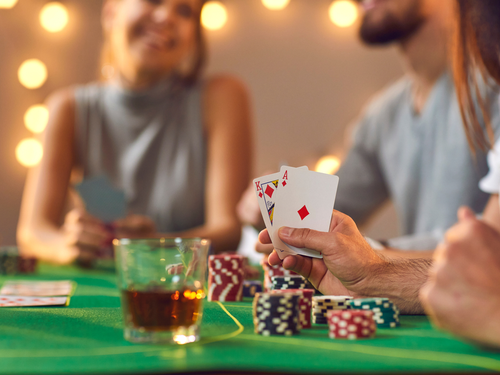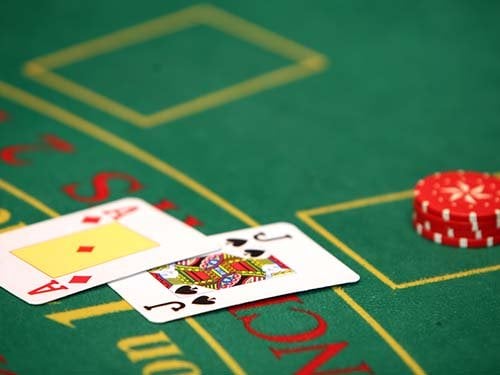-
Casinos for you

A Guide to Basic Blackjack Strategy for Beginners
- 5.0
Found this guide useful? Rate it from 1 to 5 stars.- 5.0
Improve your odds of winning blackjack by mastering some simple strategies for beginners.
Blackjack is one of the most popular casino games you can play — and for a good reason. The concept is straightforward while still maintaining the thrill that comes with playing a game of chance. However, blackjack is more than a game of chance — it’s also a game of strategy.
Most rookies don’t realize that they can improve their odds of winning by learning some basic rules and strategies. Don’t fall into that trap. Read on for a primer to basic blackjack strategies any newcomer to the game can master.
An Introduction to Blackjack Rules
Before you get caught up in strategic plays, it’s critical to understand the rules of the game. Blackjack is played with a 52-card deck. Each card in the deck has a point value:
- Ace = 1 or 11 points
- 2 through 10 = The card’s given value (e.g., a “9” equals 9 points)
- Jack, queen, and king = 10 points each
The aim is to get your hand of cards to 21 or as close to 21 as possible without going over. You win if you manage to get closer to this goal than the dealer or the house. If you go over 21, you’ve gone “bust.” Here’s how it all plays out:
- The players place their bets.
- The dealer distributes two cards to each player. These are face down.
- The dealer also distributes two cards to themselves. One of the dealer’s cards will be face up, while the other will remain face down. This face-down card is the “hole card.” The face-up card is the “up card,” which will factor into your strategy (more on that below).
-
Based on the two cards they have in front of them, the player can decide to take certain actions to try to reach 21 and beat the dealer:
- Stand: The player keeps the cards they have and doesn’t take another card from the dealer.
- Hit: The player receives another card from the dealer. A player can hit multiple times (until they hit blackjack or bust).
- Double down: The player doubles their initial bet and receives just one more card from the dealer.
- Split: If a player’s opening hand (the first two cards they get) is a pair worth 10 points each, they can choose to split that opening hand into two hands. They then play both hands at once.
- Surrender: If a player’s opening hand is bad, they can surrender and yield that hand. The player gets back half of their bet when they choose to surrender, but not all tables permit surrendering.
The ideal hand to achieve is the “blackjack,” which consists of 21 points made up of one ace and one face card (jack, queen, or king). A player who gets a blackjack is an automatic winner.
Blackjack Strategies to Help You Win
In blackjack, you’re always pitted against the dealer or the house. Effective blackjack strategies are rooted in mathematical possibility. A good strategy will increase your odds of beating the dealer, while a bad one will increase the dealer’s odds of winning. While there is no way to guarantee a winning outcome, learning these strategies puts math on your side and increases your odds of success.
Play It Safe to Start
Reading about blackjack isn’t the same as playing a game. Even if you’ve done extensive research and memorized hit charts and strategies, go slow to start. If you’re betting, start small. If you’re playing with a live dealer, going slow also gives you a chance to gauge whether they’re having a hot streak or a cold streak. If the dealer is in the midst of a winning streak, you don’t want to be their next victim.
On a similar note, avoid taking the “first base seat” when you are playing a live game (the first seat on the far right when facing the dealer) because it’s the first seat to which the dealer deals. Sitting here requires you to act fast and puts on added pressure, while sitting further down the table allows you more time to consider your actions.
Look at the Dealer’s Up Card
Before you make any decisions about what to do with your own hand, check out the dealer’s up card. Again, you are playing against the dealer. A smart strategy will take into account the strength of their hand. Don’t think about other players — you aren’t playing against them.
A bad up card would be 2 through 6. If the dealer has a 6 or lower, you will want to play your hand more conservatively. In this case, it’s highly likely that the dealer will go bust. Remember, you automatically win if the dealer busts, so there’s no point in taking risks. A good up card would be 7 through ace, which gives the dealer a better probability of getting close to 21. If the dealer has a 7 or higher showing, you can play more aggressively. The dealer is more likely to end up with a higher total — which you’ll have to beat to win.
Master the Blackjack Hit Chart
A blackjack hit chart tells you exactly when to take a certain action (e.g., split versus stand) based on the cards you have in your hand. It addresses what you should do based not only on your hand but also on the dealer’s up card. For example, if you have a 9 and the dealer’s up card is a 2, you should hit. However, if you have a 13 and the dealer’s up card is a 2, you should stand.
There are many different combinations possible; memorizing a full blackjack hit table will take time. It’s well worth the effort, however. Over time, it will become second nature and you will know exactly when to take each action. Again, while there’s no way to guarantee a win, this approach increases the probability of a win. Here’s a hit chart to get you started.
Split Aces and 8s Every Time
A pair of 8s gives you a 16. According to blackjack rules, the dealer must hit on any hand of 16 or less. If you don’t split your 8s, you have a good chance of going bust. A pair of aces gives you a value of 2 or 12, neither of which is favorable. Split the aces and hope for high-value number cards from 7 to 10.
Know a Hard Hand From a Soft Hand
A “soft” hand is one that has an ace as one of the first two cards. The ace counts as 11 points. A “hard” hand is one that does not have an ace to start. Alternatively, a hard hand can refer to an ace that can only be counted as a 1. Knowing how to play based on a hard versus soft hand is critical.
For example, you should always stand on a hard 17 or higher. You don’t have to hit on this (it’s above the dreaded 16 mark), and it’s best to stand. Think about it: There are far more cards in the deck that will bring your 17 over 21 and there are only a few cards (ace, 2, 3, or 4) that will keep you from going bust.
Never Split a Duo of Face Cards
Some rookies assume that splitting high-point cards (10s or face cards) is a good idea. They think this will double their odds of a win, netting them more cash. However, from a statistical standpoint, this isn’t a good idea. If you keep your two high-point cards in a single hand, you have a very high probability of winning with a 20-point hand. If you split, you risk losing twice as much money on lower hands.
Hone Your Blackjack Skills With GamblersPick
Practice makes perfect, especially when it comes to blackjack strategy. Test your new skills with GamblersPick. Live dealer games give you the thrill of real-time play, making for a more realistic experience similar to what you’d experience in an actual casino. In addition to offering a wide variety of online games, GamblersPick provides free information and resources for players, ensuring you have the tools you need to make smart decisions at the table.
-
CASINOS
- Popular
- Specialty
- Features
- Casinos By
-
BONUSES
- Popular
- By Type
-
GAMES
-
Slots
- Popular
- By Software
- Variations
- Features
-
Blackjack
- Popular
- Variations
- Features
-
Roulette
- Popular
- Variations
- Features
-
Video Poker
- Popular
- Variations
- Features
-
Craps
- Popular
- Features
-
Baccarat
- Popular
- Features
-
Poker
- Popular
- Variation
- Features
-
More Games
- Keno
- Bingo
- Fixed Odds
- Other Games
-
JACKPOTS
- Popular
- By Game
- By Software
-
COMMUNITY



.png.0f651d9e8ab97819d8e6bcc89d162b26.png)

.png.a0acfd195007976e042ec7e6bcc699bc.png)













